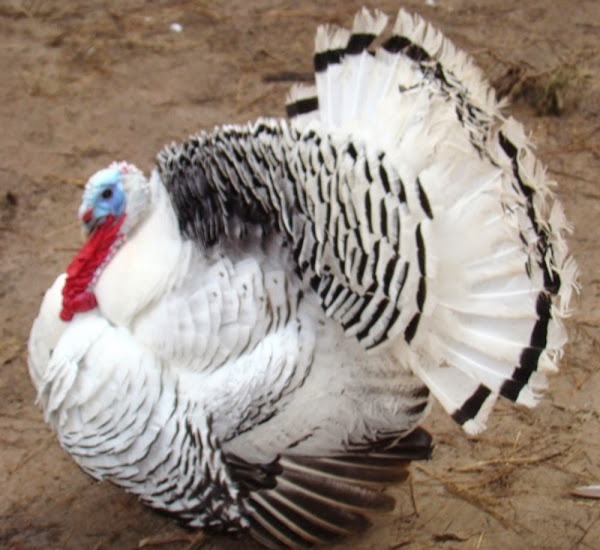The Royal Palm turkey is a breed of domestic turkey which was originated from United Kingdom. It is one of the few turkeys which is not primarily raised for meat production. It is best known as an ornamental breed with an unique appearance. The breed is mainly raised as an exhibition bird, and also kept on small farms.
The Royal Palm turkey breed has been in the United States since the 1920’s in Florida. Probably these birds were bred from European turkey breeds (because of the similar characteristics among the Crollwitzer, English Pied and Ronquieres).
The palm color pattern is available in all these three breeds. And the Royal Palm’s color was not standardized till the 1920’s. The Royal Palm turkey was recognized by the American Poultry Association in 1971.
Today it is listed as ‘Threatened‘ in the American Livestock Breeds Conservancy’s Conservation Priority List. And the breed is considered as endangered globally, although total numbers are increasing gradually. However, review full breed profile of the Royal Palm turkey breed in the following chart.
Royal Palm Turkey Characteristics
The Royal Palm turkeys are relatively smaller sized birds with very beautiful appearance. They are mainly white in coloration with sharply contrasting metalic black edging on the feathers.
The saddle is black, which provides a contrast against the white base color of body plumage. Tail of the Royal Palm turkey is pure white, with each feather having a band of black and an edge of white.
Their head, throat and wattles are red and the beak is horn-colored. Their beard is black, and the shanks and toes are deep pink.
Average live body weight of the mature Royal Palm toms is around 7.25 to 10 kg. And average live body weight of the mature hens is between 4.5 and 5.5 kg.

Uses
The Royal Palm turkey is one of the few turkey breeds which is not raised mainly for meat production. It is raised as an ornamental bird, raised mainly for exhibition purpose and also raised on small farms.
Special Notes
The Royal Palm turkeys are active, thrifty and excellent foragers. They are also very good flyers. The toms are noted for being non-aggressive, and the hens are particularly very good mothers. The hens lay pale cream to medium brown eggs with spotting.
The breed has not been purposefully selected for meat production. It is rather raised mainly as an exhibition bird, and also raised on small farms. The Royal Palm turkey breed lacks the commercial potential of the other varieties, but it has a role to play on small farms.
It is also good for home production of meat and also good for controlling insect and pest. However, review full breed profile of the Royal Palm turkey in the following chart.
| Breed Name | Royal Palm |
| Other Names | None |
| Breed Purpose | Exhibition, ornamental |
| Special Notes | Active, thrifty, excellent foragers, good flyers, the toms are noted for being non-aggressive, hens are generally very good mothers, the hens lay pale cream to medium brown eggs with spotting, today raised mainly as an exhibition bird, also raised on small farms, good for controlling pests |
| Breed Size | Small to medium |
| Tom | 7.25 to 10 kg |
| Hen | 4.5 to 5.5 kg |
| Climate Tolerance | Almost all climates |
| Color | White with sharply contrasting metalic black edging on the feathers |
| Rarity | Common |
| Country/Place of Origin | United Kingdom |







Yes, it’s true. These birds are very helpful for controlling pests, not pets. Good luck!